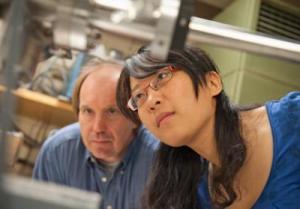Aug 26 2010
When you tear open a bag of potato chips or pop in a DVD, you're probably putting your hand on sputter deposition. No, don't run for the soap.
Sputter deposition is an industrial process used since the 1970s to spray -- sputter, that is -- thin films onto various backings, like the metallic coating on potato chip bags, the reflective surface on DVDs, or the electronics on computer chips.
 University of Vermont graduate student Lan Zhou and professor Randy Headrick made a fundamental discovery in the physics of sputter deposition that may improve computer chips, solar panels, X-ray lenses and even your next pair of mirrored sunglasses.
University of Vermont graduate student Lan Zhou and professor Randy Headrick made a fundamental discovery in the physics of sputter deposition that may improve computer chips, solar panels, X-ray lenses and even your next pair of mirrored sunglasses.
Mostly, the process works very well. In a vacuum chamber filled with an inert gas, like argon, high voltage is applied to a magnet. This energizes the argon, which, in turn, bumps particles of, say, tungsten metal from a source near the magnet out into the cloud of gas. Some of these extremely hot, charged tungsten particles zip at high speed through the argon and deposit onto the target, forming a thin film.
But sometimes the coatings peel off or the product bends in on itself and cracks, as if the film was stretched tight before it was applied to the surface. Other times, the films are just too rough. For decades, scientists have been baffled -- and manufacturers frustrated -- about why these problems happen.
Now researchers at the University of Vermont and the Argonne National Laboratory near Chicago have an explanation: "it's nanoparticles," says Randy Headrick, professor of physics at UVM, "sticking and pulling together."
The discovery, led by Headrick's graduate student, Lan Zhou, was published August 10 in the journal Physical Review B.
Using high-powered x-rays, the team measured the size of tungsten particles depositing on a target and were amazed. Above a critical pressure in the argon gas (eight one-millionths of an atmosphere), the size suddenly jumped. Instead of single atoms or several-atom molecules -- as would be expected in the high-heat, high-velocity environment of a sputter chamber -- they detected relatively gigantic blobs of hundreds of atoms: what the researchers call a "nanoparticle aggregation."
"It's a condensation, like clouds, like mist," says Headrick, "this is something we really didn't expect."
These nanoparticles pull together and fuse, drawing the film tight as tiny "nano-voids" between particles are eliminated. This can create stress in thin films strong enough to pull electronic wafers into a cup shape or roughness that distorts the delicate coatings of optical lenses.
"No one realized that in the gas phase you could produce a particle so large," says Al Macrander, a physicist at Argonne National Laboratory and a co-author on the article. "They're highly energized, so it's counter-intuitive that they would stick -- because of their velocity," he says. But stick they do.
In the sputter deposition chamber, "particles start off with temperatures of around ten thousand degrees," UVM's Randy Headrick explains. But even as they are moving in the gas, they cool slightly and "once they cool," he says, "they want to go back to being a solid."
"This has large implications," Macrander says, "for many industries, not only optics." For his part, the new findings are likely to help accelerate the creation of advanced x-ray lenses that he has been helping to develop.
So far, the efforts to make these lenses have not succeeded since the sputter deposition process has produced coatings that are still too rough with too much tension -- despite using state-of-the-art techniques.
"These lenses are intended to focus x-ray beams on smaller dimensions than have ever been achieved," he said, "down to one nanometer." To make these lenses requires more than a thousand layers of thin film. "Stress builds up and becomes a problem," he says.
The team's new insight into the basic physics of sputter deposition points the way toward a solution, but the equation is complex. "If you want to get real smooth surfaces, you have to deposit at lower argon pressures," says UVM's Lan Zhou. But at this very low pressure, the particles hit with such velocity that the thin films want to expand, creating the opposite problem by pulling films apart.
"Its still an open question: what do you do to make a film with zero stress and as smooth as possible?" says Headrick.
"At least now we understand what is happening," says Zhou, "so people can try to optimize the film deposition conditions, for structure and roughness."
Still, what are problems in one application might be a benefit in others. "There is a lot more to this finding than lens coatings," says Headrick, "there are many kinds of materials where you want to make nanoparticles, like some kinds of catalytic converters or solar cells. This could be a good way to make nanoparticles cheaply."
But the cost of figuring it out was steep. "This took years for us to understand," says Zhou, with the slightly worn smile that PhD students wear best, "it was hard to think of aggregate particles forming in the middle of a flux."